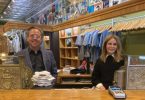Population-wide face mask use could push covid-19 transmission down to controllable levels … Even homemade masks can dramatically reduce transmission rates if enough people wear them in public. “Our analyses support the immediate and universal adoption of face masks by the public,” said Richard Stutt, who co-led the study at Cambridge.
“Widespread mask wearing could prevent covid-19 second waves, study says.” Washington Post, June 15th. (Link)
On a bright Friday morning, Clyde and I set out for Alabama to aid in my elderly mother’s care.
I-22 East toward Tupelo routes us straight into a blinding yellow blaze. We squint and bat at our car’s sun visors. On either side of us, speed blurs the landscape into streaks of pasture green and asphalt gray punctuated by the sudden, stingy shade of a highway overpass.
Eager to reduce exposure to COVID as much as possible, we drive as far as we can without stopping. Today, that puts us in Jasper, Alabama, at Love’s Travel Stop #466. When the COVID shutdown began, this roadside oasis became a ghost town: gas pumps deserted, doors propped open, the Subway closed.
Today, we wait in line at crowded pumps. Ahead of us, an unmasked elderly woman wrestles with a filthy pump handle. She tilts her head back, narrows her eyelids, and peers through her bifocals at the touchscreen controls before licking her finger and jabbing at her selection.
A lanky family group — mom, dad, and two kids, all elbows and knees and pool-tanned limbs — jogs toward the convenience store. They brush shoulders with a retired couple meandering in the same direction. A man dressed in a a stained t-shirt that does not quite cover his belly, ragged shorts, and flip flops lumbers toward the McDonald’s. None of these people wears a mask.
Inside, the floor near the cash register is marked with social distancing X’s made of black duct tape. Everyone ignores them. Behind a plexiglass divider, two weary employees ring up purchase after purchase. They stand shoulder to shoulder; neither wears a mask.
I make my way to the restrooms. As I breathe in and out, my glass fog and clear, fog and clear. The only other customer wearing a mask is a plump Black woman. She glances at me, at my mask. I nod. She nods back, raises her eyebrows, and rolls her eyes at the unmasked shoppers as if to say, “These people!”
In Colera, Alabama, we roll into a busy little Burger King on Highway 31. We’re not generally subjects of the Burger King, but the availability of an easy vegan option — the Impossible Whopper, minus the mayo — put the chain back on our list of quick and easy stops.
Once inside, I note all staff members are masked. The problem, though, is how the staff wears them. The frantic women running the drive through have their masks tucked under their chins. The young man assembling hamburgers has his nose exposed. And in back, sweeping up a disastrous spillage of frozen chicken nuggets, a moon-faced male employee wears his mask looped over only one ear. As he clears the floor of chunks of breaded, frozen meat, his mask dangles to and fro, like an elastic and paper earring.
Only the slender young man at the cash register wears his mask correctly. His voice is soft, muffled by the black fabric across his nose and mouth. When I order the Impossible Whopper, he hesitates. “You know, that’s vegan.” He looks around, as though afraid of being overheard. “I have to tell people that, because they get these Impossible Whoppers, and they get mad and bring them back.”
“It’s okay,” I say. “I’m vegan.”
He laughs. “I guess folks around here aren’t that healthy.”
In Tallassee, Alabama, Clyde makes a grocery run to the WalMart. Many employees wear masks, but, as in Colera, compliance is haphazard. Clyde sees many exposed noses, many well-protected chins, and one staff member with a mask secured atop his head like a Jewish man’s kippah.
The store is packed with shoppers, their pockets heavy with Friday paychecks. The majority come from populations known to suffer most from COVID’s most devastating symptoms: Blacks, the elderly, the infirm, the morbidly obese. Meanwhile, the others — mostly giggling teenagers — roam the store in large, tight-knit packs, social distancing be damned.
On Saturday night, I pick up dinner from a local Mexican restaurant. After finding a narrow parking space in the crowded gravel lot, I pull on my mask and go inside.
The restaurant is a sensory riot: mariachi music, boisterous tables, the hiss of fajitas, the zing of cilantro, the pungent aroma of turmeric. Dinner is in full swing, and the harried staff bustle from one booth to the next, ferrying huge trays of chips and salsa. No one in the entire restaurant wears a mask but me, and slapdash social distancing measures — faint tape marks on the floors, efforts to space out booths or tables — appear to be more for looks than anything else.
The man who takes my order peers at my mask disapprovingly, but says nothing. While I wait, I notice the stares of other diners. Most will look away when I meet their eyes; one — a grotesquely overweight man with swollen, spotted, diabetic legs — smirks at me and shakes his head. New arrivals streaming in the door see me, see my mask, and pull their children closer.
The longer I’m there, the more hostile the vibe becomes. By covering my face during a plague, I’m misbehaving, disregarding local norms, making some kind of political statement.
On the way home, we stop in Birmingham to pick up groceries at the Cahaba Village Whole Foods Market and get Clyde’s cracked iPhone screen replaced at the Apple Store at The Summit.
At Whole Foods, a masked employee drops off our bags at the car. Even so, needing a restroom break, we park and go inside. Between the parking lot and the doors, employees have erected a tent, weighted down at the four concerns by large bottles of 365-brand water. Here, the very few shoppers that didn’t bring their own masks have the opportunity to pick one up (and to slather on hand sanitizer from the industrial-sized pump on the table). Many avail themselves of the option (“Please take just one,” the sign above the box of masks implores), but a handful of others bypasses the entry station, unchallenged.
Inside, well-intentioned corporate masters have plastered the floors with red and green “Wrong Way” and “One Way” signage. This kind of traffic routing probably made sense when eager executives discussed it over a Zoom video call; in practice, it’s bewildering, and our fellow shoppers, after a few attempts to obey, give in and just go with the flow.
Sample stations — plates of cheese, chopped fruits, paper ramekins of barbecue or microwave quinoa — have become a thing of the past. (A part of me wonders why anyone ever thought eating from a pawed-through discard pile of food scraps was a good idea.) Water fountains and beer taps have been shuttered, and the tall acrylic self-serve bins of beans, grains, and nuts remain empty. The former cafe section? Closed down, converted to an employees-only temperature-checking station, and, apparently, closed down and converted again … this time to a corral for stacked cafe furniture.
As we walk out the door, we meet two incoming young employees. They flirt with each other, grinning and laughing, their masks dangling from their chins.
A few minutes away, at the Summit, eager shoppers stand in line outside the boutique shops, awaiting their turn to spend some money. As I approach the Apple Store, I’m stopped by a masked security guard. He steps out into the sunlight from the meager shade of his red pop-up tent, raises a hand, and asks, “Have you been here earlier today?”
“No.”
He nods. “Have you been coughing lately?”
“No.”
He holds up a thermal scanner. “May I take your temperature?”
“Sure.”
Whatever numbers pop up on the device satisfy him; he waves me on to the lines forming outside the Apple Store’s doors. I’m directed to a queue for pick-ups and drop-offs; the other line is for customers who want to go inside.
Every single Apple Store employee wears a mask.
The stout young man helping me makes short work of my needs. We chat about how happy I am that the Apple Store is taking precautions; he chats about how happy he is to be working in the store instead of working from home. He expedites my case, and I begin to feel an affinity for this staff member. We are urban. We are cool. We are compliant. We are on the same team.
We are masked men.
As we talk, a car drives past, piloted by a tall Black man. All the windows are down. The blaring music, with its blobby bass and distorted treble, completely obscures my new friend’s ability to communicate with me. After the cacophony fades into the distance, the Apple guy shakes his masked head. “I’m at work,” he says, “so I can’t say to you what I want to say about that.”
As we leave town, we snag take-out from Nori Thai and Sushi, a joint we choose more for its proximity than its Yelp reviews.
The cash-register attendant wears a mask; the sushi chef does not. Near the back of the cafe, a loud, large gentleman — a waiter? a manager? a cook? — lectures two captive customers about COVID-19. “I don’t know what all the fuss is about,” the man says, gesturing broadly. “It’s just the flu. It’s no different from the flu. And it’s over! Look around! People are everywhere. And no one is dropping dead in the streets! We need to open everything up. Enough of this! We need business!”
We do not eat in. We get in the car. We rub our hands with sanitizer until they feel raw. We pull off our masks. We eat our larb gai and tofu pad prik. We drive west, into the setting sun, headed home.
On this very Sunday, Alabama reported 1,014 new cases of COVID — the highest number of new cases ever reported in that state in one day. Since 74-year old Republican Governor Kay Ivey re-opened the state for business on April 30, the daily increase in confirmed cases has risen 264 percent.







